With all the research I did about Scandinavian design I got inspired to shift my topic in a different direction. As Scandinavian design is all about minimalism and reduction, I also wanted to find out more about the opposite direction: maximalism. So, my new research idea: MINIMALISM VS MAXIMALISM
As a practical part (in the very future) I could design different versions of a logo (CI/CD), from super minimalistic to super maximal (maximalism?) and see which one is perceived better/ has better brand recognition. (so minimalism and maximalism in branding/marketing). I could show the designed logos to a focus group and then evaluate which one has the best brand recognition. And in general, I want to find out more about minimalism and maximalism in advertisements, how it works, how it is perceived.
As the trend right now is going heavily in the minimalistic direction, I wanted to look at the counter-reaction and really find out more about “maximalism”. Maybe there are some misconceptions about maximalism out there. Maybe the minimalistic way is not always the right way to go. I will find out.
But for now, let’s start with some research.
Maximalism is seen as the counter-reaction to minimalism. In maximalism, the motto is: the bigger, brighter, and busier the better. In terms of color, texture, and style, maximalism does not want to focus on one of them but rather use all of them collectively (Sullivan, 2021).
Minimalism emphasises reduction and focuses on one element at a time (either color or texture or size). Maximalism on the other hand is more about features like color, shapes, textures, tones and, creating an over-the-top design/environment with them (Sullivan, 2021).
Nevertheless, maximalism is not about clutter or overstuffing. While it embraces the idea of excess, it promotes repetition, patterns, bold palettes, intricate graphic patterns, and details. Maximalism is loud. It is composed of mixed patterns and saturated colors. Maximalism has some key characteristics which are:
- Layering
- Repetitive patterns in prints such as florals, abstract, and animal prints
- Rich, bold colors
- Unique statement pieces
- Mixing and matching of textures and colors
- Multiples of items like books, statues, artworks etc.
- Blending of styles—oftentimes but not limited to classic, eclectic, and boho
(Sullivan, 2021)
